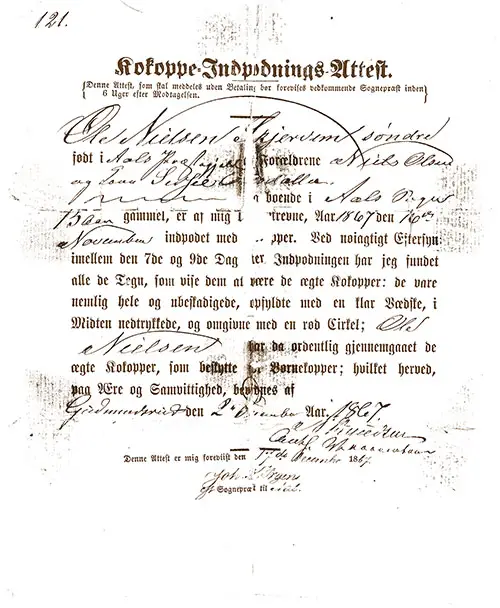Immigrant Documents Archive – Identification, Health, and Inspection Records from 1821-1939
📌 Explore a vast collection of immigrant documents, including inspection cards, vaccination certificates, ID tags, and landing records from 1821-1939. A valuable resource for genealogists, historians, and educators studying immigration history and public health policies.
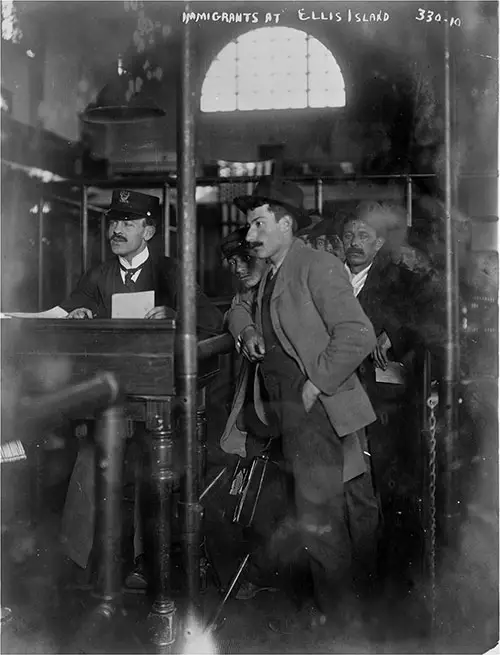
Immigrant at Registration Desk at Ellis Island ca 1910s. Bain News Service. The photograph shows a man waiting, with others in a queue behind him, at the registration desk in the immigration station on Ellis Island; an immigration official is seated at the desk. Library of Congress # 97501640. GGA Image ID # 148505c990
Immigrant Documents Archival Collection – A Vital Resource for Immigration History 📜🛂🌍
The Immigrant Documents Archival Collection is an exceptional resource for genealogists, historians, teachers, students, and anyone interested in the immigration experience. Featuring original documents spanning over a century (1821-1939), this collection provides an invaluable glimpse into immigration policies, public health regulations, and personal stories of immigrants arriving in the United States, Canada, and Australia.
From vaccination certificates to immigrant ID cards and landing papers, these documents bring history to life, offering firsthand evidence of how immigrants were identified, inspected, and admitted into new countries. The collection highlights key aspects of immigration control, including health screenings, quarantine regulations, shipboard inspections, and government-issued documentation.
Our Immigrant Document Archival Collection Includes Vaccination Certificates, Immigrant Identification Cards, Immigrant ID Tags, Alien Cards, and similar ephemera.
Genealogists will find these especially useful in identifying the documents they have in their family heirlooms. Students often find the illustrations and information ideal for completing reports on immigration for school.
Immigrants passing through Eilis Island were occasionally detained and chalked with a code letter to indicate the reason for the further examination —"K" for hernia, "L" for lung, "E" for eye, "H" for heart, "X" for mental disorder. Other numbers commonly found on the Immigrant Inspection Card were the manifest page and line number where their information was recorded. Holes on the bottom of some inspection cards were punched by the ship's surgeon during daily inspections.
Immigrant Documents Available at GG Archives

1821 Norwegian Cowpox Vaccination Certificate: Early Immunization & Immigration Health Policies
This 1821 Norwegian Cowpox Vaccination Certificate is a remarkable artifact that provides a window into early public health measures and their impact on immigration history. Issued as proof of vaccination, this document represents a pivotal moment when smallpox prevention became essential for travelers, immigrants, and seafarers—laying the groundwork for later health regulations that influenced steamship travel, Ellis Island medical inspections, and international quarantine policies.
The 1821 Cowpox Vaccination Certificate represents more than just an individual’s medical record—it is a key piece of public health history that foreshadowed mandatory immunizations for immigrants in the 19th and 20th centuries. As travelers and immigrants carried vaccination certificates, governments increasingly regulated health screenings at ports of entry, laying the groundwork for modern global health policies.
1867 Cowpox Inoculation Certificate: Early Vaccination & Immigration Health Policies
This 1867 Cowpox Inoculation Certificate for Ole Nielsen Skjervem is a fascinating historical artifact that illustrates the importance of early vaccination records in the context of immigration, public health, and genealogy. The document provides crucial details about the vaccinated individual, including their name, parents' names, age, location, and confirmation of successful inoculation against smallpox.
The 1867 Cowpox Inoculation Certificate is more than a medical record—it is a key piece of public health and immigration history that demonstrates how disease prevention shaped global migration policies. By requiring vaccination before travel, authorities helped reduce outbreaks and protect port cities—a concept that remains relevant today in global health policies.
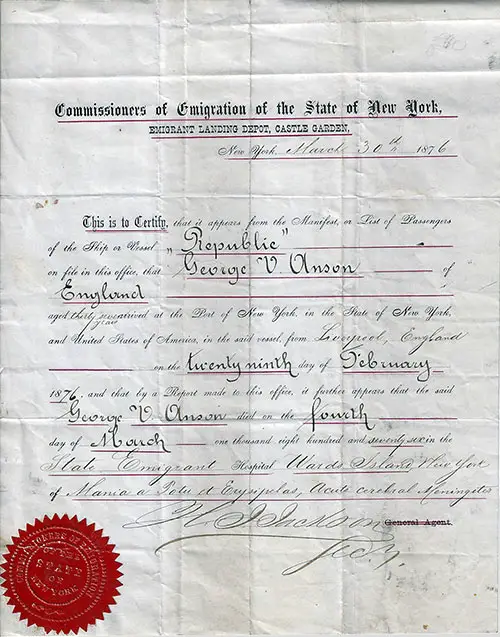
Death at Ward’s Island: A Quarantined Immigrant’s Tragic End (1876)
The story of George V. Anson, an English immigrant who arrived in New York on February 29, 1876, and perished just four days later at Ward’s Island Quarantine Hospital, is a sobering reminder of the harsh realities faced by 19th-century immigrants.
This rare death certificate offers an intimate glimpse into the intersection of immigration, public health, and quarantine policies, shedding light on the risks and vulnerabilities that many immigrants encountered upon reaching America.
Discover the rare 1876 death certificate of an immigrant at New York’s Ward Island Quarantine Hospital. This historical document sheds light on immigration, public health, and quarantine policies before Ellis Island. A must-read for teachers, students, genealogists, and historians.

This 1893 Vaccination Certificate Card issued to I. O. Kilgarriff aboard the SS City of Berlin of the American Line is an exceptional historical document illustrating the intersection of public health and immigration policies in the late 19th century. The card provided proof of smallpox vaccination, ensuring that immigrants could enter the U.S. without quarantine delays and travel freely by rail and steamship within the country.
The 1893 Vaccination Certificate from the SS City of Berlin is a powerful historical document that reveals the strict medical requirements imposed on immigrants before they could enter the U.S. It serves as a testament to the role of steamship medical inspections in controlling disease outbreaks, protecting port cities, and ensuring safer immigration practices.

This 1900 Proof of Registration for Military Service belonging to Kristian Johannes Jansen is an important historical document that illustrates how military conscription laws impacted Danish emigrants before they left for America. It serves as both a military record and an immigration artifact, offering insight into the obligations and challenges faced by young men emigrating from Denmark in the early 20th century.
For teachers, students, genealogists, and historians, this document provides a valuable case study on European military conscription, immigration policies, and personal records of emigrants. It is particularly useful in understanding how Danish emigrants navigated their legal responsibilities before embarking on their journey to the United States.


🛂 Early 1900s Immigration Landing Cards: Steamship Arrival Documents for the U.S. & Canada
This collection of early 1900s immigration landing cards provides a rare glimpse into the immigration process for passengers traveling to North America aboard transatlantic steamships. These primary source documents offer an essential resource for teachers, students, genealogists, and historians interested in understanding how immigrants were processed upon arrival in the United States and Canada.
Landing cards, such as those issued aboard the SS Corsican of the Allan Line, were an important component of immigration procedures. These cards helped track immigrants, verify their identity, and streamline the processing of passengers arriving from overseas.
For genealogists, these landing cards serve as valuable immigration records, offering insights into ancestral migration patterns. For historians, they reflect how governments regulated immigration at the turn of the century. For teachers and students, they provide a compelling visual aid to discuss the experiences of early immigrants.

🛂 Immigrant Inspection Card (1901) – Ellis Island Steerage Passenger Arrival on RMS Oceanic
The Immigrant Inspection Card from the RMS Oceanic (1901) is a remarkable historical artifact that provides a rare glimpse into the immigration experience of steerage passengers arriving at Ellis Island. For teachers, students, genealogists, and historians, this document offers a firsthand look at the bureaucratic process immigrants underwent before setting foot in America.
Issued to steerage-class passengers, this card served as proof of health clearance and official documentation for immigrants traveling from Liverpool to New York. The multiple language translations on the reverse side highlight the diverse backgrounds of those entering the U.S. at the dawn of the 20th century.
This inspection card from 1901 is especially valuable for family historians tracing Norwegian ancestry, as the immigrant listed resided in Trondhjem (modern-day Trondheim), Norway before making the journey to the United States.

🛂 1902 Immigrant Inspection Card - RMS Germanic Steerage Passenger Arrival at Ellis Island
The 1902 Immigrant Inspection Card from the RMS Germanic is a fascinating primary source document that sheds light on the immigration experience of Norwegian steerage passengers traveling to America. This artifact offers tremendous value for teachers, students, genealogists, and historians, providing a rare look into early 20th-century immigration procedures, health screenings, and documentation requirements.
Issued to Hans Johansen Røsholt, a 21-year-old Norwegian immigrant from Lårdal, Norway, this card served as official proof of inspection, vaccination, and permission to travel. It also helped immigrants avoid detention at U.S. quarantine stations or while traveling by rail after arrival.
This document is an exceptional resource for those researching Ellis Island immigration, Norwegian migration patterns, and White Star Line passenger records.

🛂 1903 Danish Emigrant Inspection Card - RMS Saxonia Steerage Passenger Arrives in Boston
The 1903 Immigrant Inspection Card from the RMS Saxonia is a rare and significant historical artifact that provides insight into the immigrant experience, health regulations, and U.S. immigration policies at the turn of the 20th century. This card, issued to Danish emigrant Kristian Johannes Jansen, serves as a primary source document, illustrating the journey from Copenhagen to America via Liverpool and the meticulous screening process required for entry into the United States.
For teachers, students, genealogists, and historians, this page is a goldmine of information showcasing immigrant travel documentation, public health measures, and transatlantic voyage logistics.
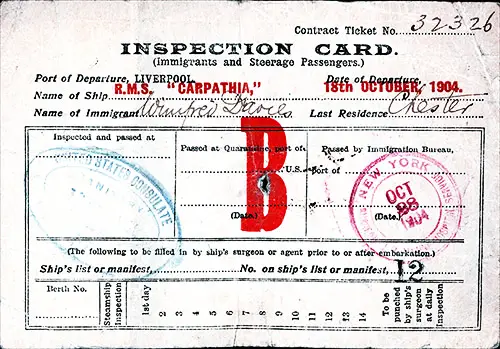
🛂 1904 RMS Carpathia Immigrant Inspection Card – A Rare Document from the Ellis Island Era
The 1904 Immigrant Inspection Card from the RMS Carpathia is an exceptional historical artifact that offers a firsthand glimpse into early 20th-century immigration procedures. Issued to Winifred Davies of Chester, England, this document provides valuable information about her transatlantic journey, health screenings, and arrival process in America.
For teachers, students, genealogists, and historians, this page is a fascinating resource, showcasing the Cunard Line’s role in immigration, public health measures for steerage passengers, and the rigid inspection protocols enforced at Ellis Island.

🛂 1909 SS Dominion Canadian Immigrant Inspection Card – A Rare Record of Family Migration to Canada
The 1909 Canadian Immigrant Inspection Card from the SS Dominion offers a fascinating glimpse into immigration procedures for families traveling to Canada in the early 20th century. Issued to the Murray family (Thomas, Annie, and their three children), this document confirms their medical examination and civil clearance at the Port of Québec upon arrival on 14 November 1909.
For teachers, students, genealogists, and historians, this article serves as a primary source for understanding Canadian immigration processes, public health screenings, and documentation requirements for arriving settlers. It highlights the rigorous yet organized process of inspecting and recording new immigrants, providing valuable context for those researching family history or studying migration trends.

🛂 1910 RMS Lusitania Immigrant Inspection Card – A Historic Look at U.S. Immigration Procedures
The 1910 immigrant inspection card from the RMS Lusitania is a remarkable historical document that provides insight into the experience of steerage passengers traveling to America in the early 20th century. Issued to Swedish immigrant K. E. Paulson, this card confirmed that he departed from Liverpool on 9 July 1910, underwent medical inspection, and was approved for entry at Ellis Island upon arrival in New York.
For teachers, students, genealogists, and historians, this primary source document is an invaluable resource for studying immigration procedures, public health policies, and the realities of transatlantic travel aboard one of history’s most famous ocean liners—the RMS Lusitania.

🛂 1910 RMS Lusitania Immigrant ID Tag – A Rare Glimpse Into Ellis Island Immigration Processing
A Tangible Link to the Immigrant Experience
The RMS Lusitania immigrant ID tag from 9 July 1910 is an extraordinary artifact that provides insight into the arrival process for steerage passengers at Ellis Island.
Issued to Swedish immigrant K. E. Paulson, this tag was worn on the passenger’s outer garment and contained essential information about their journey, including ship name, departure date, and manifest details.
For teachers, students, genealogists, and historians, this primary source document is invaluable in understanding the immigrant experience, the logistics of processing thousands of arrivals daily, and the role of major transatlantic ocean liners in facilitating global migration.

🌍 A Vital Document for Early 20th-Century Immigrants
The SS President Grant immigrant inspection card, issued on 24 April 1912, is an exceptional historical document that offers a firsthand look at the immigration process for steerage passengers. This inspection card, issued by the Hamburg-America Line, belonged to Austrian immigrant Anna Grimko and served as proof of passing immigration medical and legal checks.
For teachers, students, genealogists, and historians, this artifact is an invaluable primary source, shedding light on the procedures faced by immigrants arriving in America, the significance of transatlantic steamship lines, and the challenges faced by steerage passengers at Ellis Island.
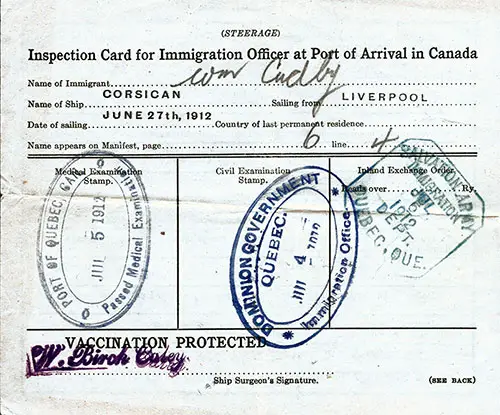
🛂 SS Corsican 1912 Immigration Inspection Card – Canada’s Steerage Passenger Records
The Canadian Immigrant Inspection Card issued to steerage passenger William (Wm.) Cudby aboard the SS Corsican of the Allan Line provides a remarkable historical artifact that sheds light on early 20th-century immigration procedures in Canada. This primary source document serves as a crucial research tool for genealogists, historians, teachers, and students interested in the processes of immigrant arrival, health screening, and inland travel assistance.
Steerage passengers were often subjected to rigorous inspections, and this card represents a critical piece of evidence that immigrants needed to retain for three years, proving their compliance with Canadian immigration and health regulations.
💰 Norwegian Bank Note (1913) – Immigration Loan for Passage to the U.S.
The Norwegian Bank Note of 1913 provides a remarkable insight into the financial challenges and solutions that enabled Norwegian immigrants to pursue the American Dream. Issued by Spareskillingsbanken, Trondhjem, this loan document was used to finance the journey of Ludvig Kristian Gjønvik from Norway to the United States.
This primary source document is invaluable for genealogists, historians, educators, and students, as it showcases how working-class emigrants funded their transatlantic journeys. Unlike wealthier travelers, many Norwegian emigrants relied on family sponsorships or personal loans to pay for passage on steamships bound for North America.

This 1913 Immigrant Inspection Card from the Cunard Line's RMS Laconia is a fascinating primary source document that provides a first-hand look into the transatlantic immigration process of the early 20th century. Issued to Norwegian immigrant Ludvig Gjønvik, this card was an essential part of the immigration journey, ensuring compliance with medical, sanitary, and quarantine regulations upon arrival in the United States.

1913 SS Seydlitz Australian Immigration Control Card – A Rare Glimpse into Pre-WWI Immigration
The 1913 Australian Immigration Control Card, issued aboard the SS Seydlitz of North German Lloyd, provides an exceptional insight into pre-World War I immigration policies in Australia. This document was carried by a German immigrant and presented to Australian Immigration Officers at Fremantle, serving as proof of medical clearance and compliance with immigration regulations.
For teachers, students, genealogists, and historians, this card offers a unique window into Australia’s immigration process, public health measures, and the significance of steamship travel in global migration during the early 20th century. It also highlights Australia’s strict medical inspection policies for arriving immigrants, a practice that mirrored similar procedures in the United States and Canada.

1915 Canadian Steerage Immigrant Inspection Card – SS Missanabie
This 1915 Canadian Steerage Immigrant Inspection Card, issued to a passenger aboard the SS Missanabie, offers a rare and fascinating insight into the Canadian immigration process during World War I. This card not only documents the arrival of an immigrant in Canada but also highlights the medical, civil, and vaccination requirements for steerage passengers.
For teachers, students, genealogists, and historians, this document provides a detailed glimpse into the bureaucratic, medical, and logistical challenges faced by steerage-class immigrants. It also stands out because the SS Missanabie had an exceptionally short service life, being torpedoed and sunk by a German U-boat in 1918. This adds an additional historical significance to the document, making it an exceptionally rare piece of immigration history.
1915 German Certificate of Innocence – Immigration & Character Verification
The 1915 German "Zeugnis der Unbescholtenheit" (Certificate of Innocence) is a fascinating and historically significant immigration document. This certificate served as an official character reference, attesting that the bearer had no criminal record, no moral misconduct, and was of good standing. Carried by a German immigrant on his 1921 voyage from Bremen to New York, this document provides unique insight into the role of moral and character assessments in immigration history.
For teachers, students, genealogists, and historians, this document offers a rare glimpse into the personal and bureaucratic aspects of German emigration during the early 20th century. It highlights the importance of moral standing in securing passage and acceptance in a new country—a requirement that was often overlooked compared to health screenings and financial solvency.

1921 RMS Olympic Transmigrant Certificate – U.S. Public Health Inspection for Immigrants
This 1921 Transmigrant Certificate, issued to a third-class passenger on the RMS Olympic, serves as a critical historical document highlighting the stringent public health regulations imposed on immigrants before their transatlantic journey. It provides valuable insight into the immigration process, health inspections, and sanitation protocols that shaped the experience of European migrants traveling to America in the early 20th century.
For teachers, students, genealogists, and historians, this document is an exceptional primary source that reflects the public health concerns of the time, the role of medical inspections in immigration control, and the experience of third-class passengers on steamships. It is particularly relevant for studies on Ellis Island, quarantine policies, and early 20th-century public health regulations.
1922 HAPAG Passenger Transport Notification – Emigrant Travel Requirements to the U.S.
This 1922 Passenger Transport Notification from HAPAG (Hamburg-America Line) is a rare and invaluable artifact, shedding light on the rigorous immigration process for European emigrants traveling to the United States. The document serves as an official notification from the HAPAG Passenger Transport Department, detailing essential steps for obtaining travel documentation, securing visas, undergoing medical examinations, and finalizing departure plans.
For teachers, students, genealogists, and historians, this document is an exceptional primary source that helps contextualize early 20th-century immigration policies, the role of shipping companies in managing migrant travel, and the bureaucratic hurdles faced by immigrants before they could even set sail.

1922 Canadian Alien Card – A Glimpse into Early 20th Century Immigration via SS Canada
This page presents a fascinating archival document—a 1922 Canadian Alien Card issued by the White Star Dominion Line for passengers on board the SS Canada. The card, which was to be presented to the Canadian Aliens' Officer upon arrival, captures the detailed process of immigration control and identity verification that was pivotal in the early 20th century. The artifact not only reflects the bureaucratic rigor of the time but also offers a personal glimpse into the immigration experience.

SS Drottningholm Inspection Card - 1923
An extraordinary artifact from the Golden Age of transatlantic migration, this US Immigration Inspection Card, issued to Earnst O. W. Carsuer, documents his passage aboard the SS Drottningholm of the Swedish American Line. Dated 15 September 1923, this card served as both proof of identity and clearance for immigration officials upon arrival in the United States.
Provenance: From the esteemed private collection of Paul K. Gjenvick
Estimated Auction Value: $180 to $250 USD


1923 Lithuanian Immigrant Documents – A Journey Through Ellis Island
This rare archival collection follows the immigration journey of 65-year-old Barbara Vitkiene, a Lithuanian immigrant who arrived at Ellis Island in 1923. It includes critical documents such as an inspection card, immigrant ID tag, and passenger manifest extracts, each offering unique insight into the Ellis Island immigration process.
📌 This collection is invaluable for:
✅ Teachers & Students – Understanding Ellis Island's immigrant processing system
✅ Genealogists – Tracing Lithuanian immigration records and name changes
✅ Historians – Studying health regulations and inspection protocols
✅ Anyone interested in family history & immigration
📖 Students writing essays on immigration history can use these documents as primary sources to explore themes of health screenings, identity documentation, and the journey of immigrants through Ellis Island.

1928 U.S. Immigrant ID Card for Non-Quota Visa – A Rare Immigration Document
The 1928 Immigrant Identification Card, issued by the U.S. Department of Labor, is a historically significant artifact that provides insight into early 20th-century immigration procedures. This particular document, belonging to Jose Mario Farban of Lima, Peru, illustrates the meticulous record-keeping and regulatory frameworks imposed on immigrants entering the United States.
This non-quota immigration visa was an important classification that allowed certain immigrants—such as refugees, professionals, or family reunification cases—to enter the U.S. without being subject to annual immigration quotas.


RMS Scythia Immigration Inspection Cards – Norwegian Immigrants’ Journey to the U.S. (1928)
The RMS Scythia Immigrant Inspection Card Collection provides a rare and insightful look at how immigrants were processed upon arriving in the United States in 1928. This collection, featuring original inspection cards from Norwegian immigrants Lauri A. Grava and Josua Grava, highlights the bureaucratic procedures, medical examinations, and documentation required for entry into the U.S.

Immigrant ID & Vaccination Certificate – A Glimpse into 1930s Immigration Processes
The "Immigrant ID & Vaccination Certificate – 1930" page provides a fascinating and rare historical artifact documenting the immigration process for an Italian immigrant in the early 20th century.
This highly relevant resource captures:
✅ The importance of official documentation for immigrants
✅ The strict health regulations required before entering the U.S.
✅ A deeply personal immigration story, tracing an individual's journey
✅ A historical perspective on how immigrants were processed at ports like Naples
This article is especially useful for:
✔ Teachers & Students – Studying early 20th-century immigration, health regulations, and Ellis Island procedures
✔ Genealogists – Understanding ancestral migration patterns and historical documentation
✔ Historians – Researching immigration laws and public health measures of the era
✔ Anyone interested in immigration history – Examining the challenges and protocols faced by immigrants
📌 Encourage students to use this page when writing essays on historical immigration practices, Ellis Island health screenings, or the significance of immigrant documentation.

1931 RMS Duchess of York U.S. Landing Card – A Rare Immigration Document
The United States Landing Card issued to Elizabeth Hausen in 1931 is a remarkable piece of immigration history that provides insight into early 20th-century migration policies, port inspections, and passenger documentation. This card, issued on the Canadian Pacific Steamship RMS Duchess of York, signified official clearance by a U.S. Immigration Inspector upon arrival.
For teachers, students, genealogists, and historians, this document offers a tangible link to the immigration experience of transatlantic travelers. It serves as proof of how the United States processed immigrants before entry, demonstrating the rigorous medical and legal checks enforced at major ports like Liverpool and New York.

1939 Canadian Immigration Identification Card – Third Class Passenger Documentation
The Canadian Immigration Identification Card issued in 1939 to Rose McMahon, a third-class passenger aboard the Duchess of York, is an exceptional piece of historical documentation that sheds light on immigration procedures, travel regulations, and government record-keeping practices in early 20th-century Canada.
This identification card, stamped by the Quebec Immigration Office on 22 September 1939, would have been a critical document for immigrants entering Canada, proving their legal entry and ensuring compliance with Canadian immigration policies.
For teachers, students, genealogists, and historians, this document offers a rare glimpse into how immigrants were processed upon arrival. It serves as a key research artifact, helping trace family migration routes, understand immigration control measures, and analyze the movement of people across borders just before World War II.

1894 Steerage & Cabin Passenger Inspection Cards – Immigration Control & Public Health Regulations
The Steerage and Cabin Passenger Inspection Cards of 1894 provide a critical window into U.S. immigration history, illustrating how immigrants were screened, monitored, and processed before and after arrival. These documents were essential to public health enforcement, government regulations, and travel documentation for steerage-class immigrants, ensuring that those arriving in the United States had undergone medical examinations, vaccinations, and baggage disinfection procedures.
For teachers, students, genealogists, and historians, these inspection cards offer a rare insight into the meticulous bureaucratic processes involved in early U.S. immigration control. The regulations were implemented at a time when quarantine and disease prevention were top concerns, particularly in response to cholera outbreaks and other infectious diseases.
Why This Collection is Essential
For Teachers & Students 📚
✅ Provides primary source documents for immigration research and essays
✅ Offers real-world examples of historical immigration procedures
✅ Helps students understand the challenges immigrants faced upon arrival
✅ A great resource for studying public health measures in immigration history
For Genealogists 🏡
✅ Helps identify ancestral immigration records
✅ Provides clues about an immigrant’s journey, ship of passage, and inspection details
✅ Helps interpret vintage immigrant documents found in family archives
✅ Offers insight into medical clearances and quarantine procedures
For Historians & Immigration Policy Researchers 🏛
✅ Showcases early government efforts to regulate immigration
✅ Demonstrates how public health concerns shaped immigration laws
✅ Highlights immigration trends, shipboard policies, and processing procedures
✅ Offers a rare look at immigration control in the U.S., Canada, and Australia
Most Fascinating Sections & Documents
1. Vaccination Certificates & Health Inspections 🩺
Health screenings were a critical part of the immigration process, as authorities feared the spread of contagious diseases. The collection includes:
📜 1821 Norwegian Cowpox Vaccination Certificate – One of the earliest examples of mandatory immunization for travelers, foreshadowing later Ellis Island medical exams.
📜 1893 Vaccination Certificate from SS City of Berlin – Shows how steamship companies enforced smallpox vaccinations before allowing passengers to travel.
📜 1921 RMS Olympic Transmigrant Certificate – Proof that immigrants were inspected, disinfected, and found vermin-free before sailing.
💡 Why It’s Interesting:
These documents reveal how public health policies shaped immigration, emphasizing the role of disease control in border security.
2. Immigrant Inspection & Identification Cards 🛂
These documents helped authorities track, examine, and process immigrants at major entry points such as Ellis Island, Boston, Quebec, and Fremantle (Australia).
📜 1894 U.S. Steerage & Cabin Passenger Inspection Cards – A precursor to modern travel visas, proving that steerage-class immigrants were medically examined.
📜 1901 & 1902 Ellis Island Immigrant Inspection Cards (RMS Oceanic & RMS Germanic) – Helped identify passengers who passed medical inspections.
📜 1939 Canadian Immigration ID Card – Issued to a third-class passenger aboard the Duchess of York, proving legal entry into Canada.
💡 Why It’s Interesting:
These documents offer a tangible connection to an ancestor’s immigration journey, providing names, ship details, and medical clearances.
3. Landing & Alien Cards – Proof of Arrival & Legal Status 🛳
Many immigrants had to carry proof of legal entry, especially when traveling between countries or changing immigration status.
📜 1907 Allan Line Landing Card for SS Corsican – A rare document issued for passengers entering Canada.
📜 1922 Canadian Alien Card (SS Canada) – Required for non-citizens traveling within Canada, demonstrating how immigration policies evolved to track movement.
📜 1931 U.S. Landing Card (RMS Duchess of York) – Proof that the bearer had passed U.S. immigration inspections upon arrival.
💡 Why It’s Interesting:
These documents show how governments regulated immigrant movement, similar to modern-day visas and residency permits.
4. Immigration & Military Service – The Role of Conscription 🪖
Military obligations often impacted an immigrant’s ability to leave their home country. Some had to prove they were registered for military service before emigrating.
📜 1900 Danish Military Registration Document – Issued to Kristian Johannes Jansen, proving he had completed conscription before leaving for America.
📜 1915 German "Certificate of Innocence" – A unique document proving that a German emigrant had no criminal or moral issues before departing.
💡 Why It’s Interesting:
Many young men delayed or avoided emigration due to military service obligations, affecting migration patterns in Europe.
5. Rare Shipboard Immigration Documents 🚢
Steamship companies played a major role in regulating immigration, often acting as the first line of inspection before departure.
📜 1922 HAPAG Passenger Transport Notification – A detailed telegram from the Hamburg-America Line, instructing an emigrant on visa costs, passport requirements, and ship schedules.
📜 1923 RMS Scythia Immigration Inspection Cards (Norwegian Immigrants) – Proving that immigrants had passed medical and document checks before arrival in the U.S.
💡 Why It’s Interesting:
These documents highlight how shipping lines worked closely with immigration authorities to enforce entry requirements.
Key Takeaways for Research & Essay Writing
📌 For Students & Teachers:
🔹 Useful for studying public health policies and their impact on immigration regulations.
🔹 Offers real-world examples of how governments controlled immigration.
🔹 Helps visualize the immigrant experience through official documents.
📌 For Genealogists & Family Historians:
🔹 A valuable resource for identifying an ancestor’s immigration records.
🔹 Helps decipher old immigrant documents and their significance.
🔹 Provides context for why some passengers were detained or required extra medical checks.
📌 For Historians & Immigration Policy Researchers:
🔹 Demonstrates how early immigration policies focused on public health and identity verification.
🔹 Highlights the role of steamship companies in enforcing government regulations.
🔹 Offers primary source evidence of how immigrants were processed before and after arrival.
Final Thoughts: A Rare and Valuable Resource for Immigration History
The Immigrant Documents Archival Collection is a one-of-a-kind historical resource that brings the immigrant experience to life. Covering more than a century of immigration history (1821-1939), this collection offers critical insights into health screenings, landing procedures, identity verification, and travel regulations.
For teachers and students, these documents serve as powerful primary sources for studying early immigration policies and public health enforcement.
For genealogists, they provide a direct link to an ancestor’s migration story.
And for historians, they reveal how immigration laws shaped global migration patterns.
💡 How do modern immigration policies compare to these historic health screenings?
What lessons can we learn from past efforts to control disease spread among travelers? 🤔
🔍 Explore the collection to uncover how immigration processes evolved over time! 🛂📜

